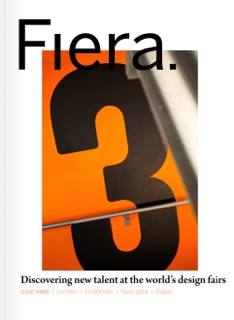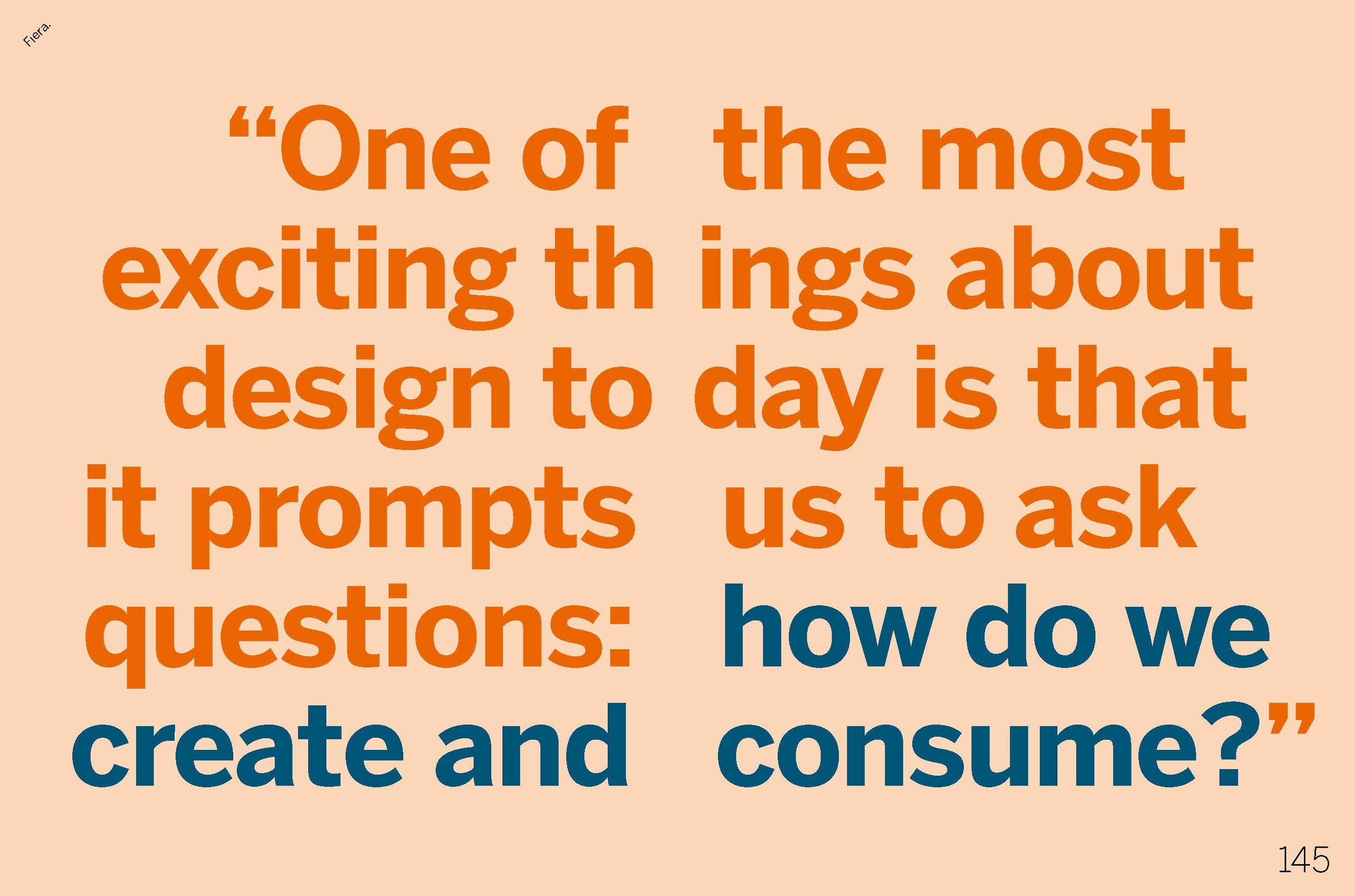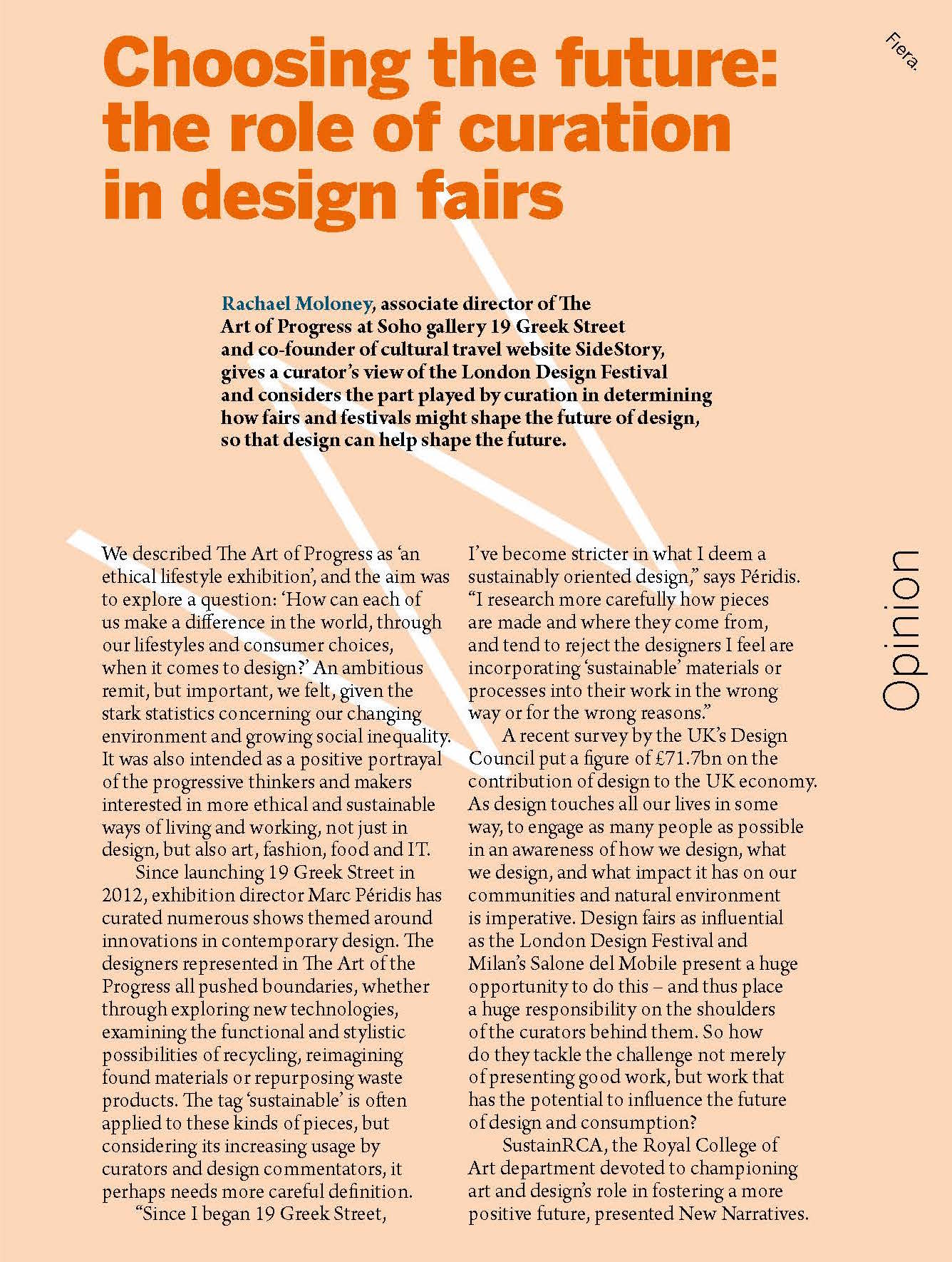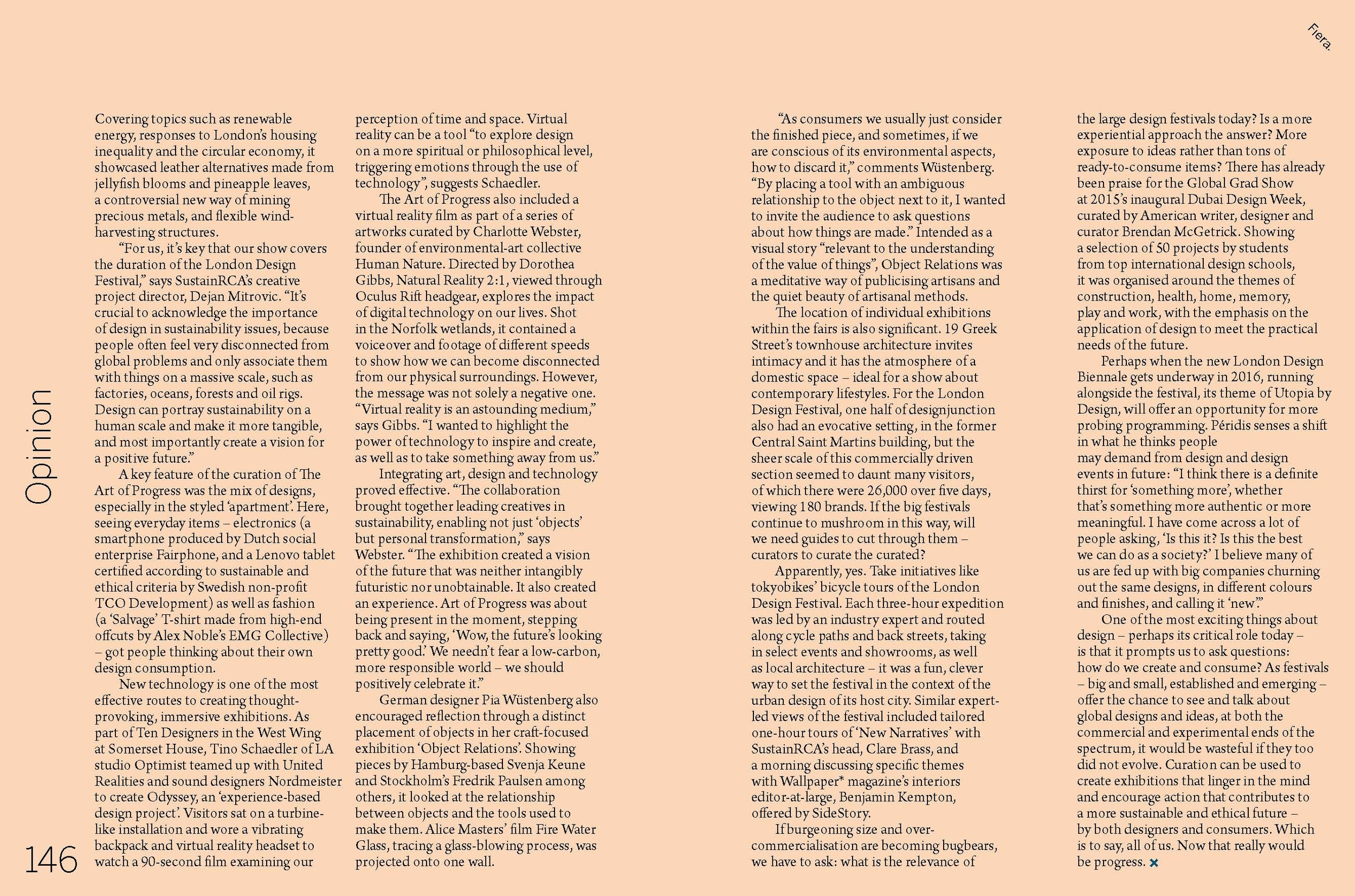Rachael Moloney, associate director of the Art of Progress at Soho gallery 19 greek street and co-founder of cultural travel website SideStory, gives a curator’s view of the London Design Festival and considers the part played by curation in determining how fairs and festivals might shape the future of design, so that design can help shape the future.
“One of the most exciting things about design today is that it prompts us to ask questions: how do we create and consume?”
We described the Art of Progress as ‘an ethical lifestyle exhibition’, and the aim was to explore a question: ‘How can each ofus make a difference in the world, through our lifestyles and consumer choices, when it comes to design?’ An ambitious remit, but important, we felt, given the stark statistics concerning our changing environment and growing social inequality. It was also intended as a positive portrayal of the progressive thinkers and makers interested in more ethical and sustainable ways of living and working, not just in design, but also art, fashion, food and IT.
Since launching 19 greek street in 2012, exhibition director Marc Péridis has curated numerous shows themed around innovations in contemporary design. The designers represented in the Art of the Progress all pushed boundaries, whether through exploring new technologies, examining the functional and stylistic possibilities of recycling, reimagining found materials or repurposing waste products. The tag ‘sustainable’ is often applied to these kinds of pieces, but considering its increasing usage by curators and design commentators, it perhaps needs more careful definition.
“Since I began 19 greek street, I’ve become stricter in what I deem a sustainably-oriented design,” says Péridis. “I research more carefully how pieces are made and where they come from, and tend to reject the designers I feel are incorporating ‘sustainable’ materials or processes into their work in the wrong way or for the wrong reasons.”
A recent survey by the UK’s Design Council put a figure of £71.7bn on the contribution of design to the UK economy. As design touches all our lives in some way, to engage as many people as possible in an awareness of how we design, what we design, and what impact it has on our communities and natural environment is imperative. Design fairs as in influential as the London Design Festival and Milan’s Salone del Mobile present a huge opportunity to do this – and thus place a huge responsibility on the shoulders of the curators behind them. So how do they tackle the challenge not merely of presenting good work, but work that has the potential to influence the future of design and consumption?
SustainRCA, the Royal College of Art department devoted to championing art and design’s role in fostering a more positive future, presented New Narratives.
Covering topics such as renewable energy, responses to London’s housing inequality and the circular economy, it showcased leather alternatives made from jellyfish blooms and pineapple leaves, a controversial new way of mining precious metals, and flexible wind-harvesting structures.
“For us, it’s key that our show covers the duration of the London Design Festival,” says SustainRCA’s creative project director, Dejan Mitrovic. “It’s crucial to acknowledge the importance of design in sustainability issues, because people often feel very disconnected from global problems and only associate them with things on a massive scale, such as factories, oceans, forests and oil rigs. Design can portray sustainability on a human scale and make it more tangible, and most importantly create a vision for a positive future.”
A key feature of the curation of the Art of Progress was the mix of designs, especially in the styled ‘apartment’. Here, seeing everyday items – electronics (a smartphone produced by Dutch social enterprise Fairphone, and a Lenovo tablet certified according to sustainable and ethical criteria by Swedish non-profit TCO Development), as well as fashion (a ‘Salvage’ T-shirt made from high-end offcuts by Alex Noble’s EMG Collective) – got people thinking about their own design consumption.
New technology is one of the most effective routes to creating thought-provoking, immersive exhibitions. As part of Ten Designers in the West Wing at Somerset House, Tino Schaedler of LA studio Optimist teamed up with United Realities and sound designers Nordmeister to create Odyssey, an ‘experience-based design project’. Visitors sat on a turbine-like installation and wore a vibrating backpack and virtual reality headset to watch a 90-second film examining our perception of time and space. Virtual reality can be a tool “to explore design on a more spiritual or philosophical level, triggering emotions through the use of technology”, suggests Schaedler.
The Art of Progress also included a virtual reality film as part of a series of artworks curated by Charlotte Webster, founder of environmental-art collective Human Nature. Directed by Dorothea Gibbs, Natural Reality 2:1, viewed through Oculus Rift headgear, explores the impact of digital technology on our lives. Shot in the Norfolk wetlands, it contained a voiceover and footage of different speeds to show how we can become disconnected from our physical surroundings. However, the message was not solely a negative one. “Virtual reality is an astounding medium,” says Gibbs. “I wanted to highlight the power of technology to inspire and create, as well as to take something away from us.”
Integrating art, design and technology at 19 greek street proved impactful. “The collaboration brought together leading creatives in sustainability, enabling not just ‘objects’ but personal transformation,” says Webster. “The exhibition created a vision of the future that was neither intangibly futuristic nor unobtainable. It also created an experience. Art of Progress was about being present in the moment, stepping back and saying, ‘Wow, the future’s looking pretty good.’ We needn’t fear a low-carbon, more responsible world – we should positively celebrate it.”
German designer Pia Wüstenberg also encouraged reflection through a distinct placement of objects in her craft-focused exhibition ‘Object Relations’. Showing pieces by Hamburg-based Svenja Keune and Stockholm’s Fredrik Paulsen among others, it looked at the relationship between objects and the tools used to make them. Alice Masters’ film Fire Water Glass, tracing a glass-blowing process, was projected onto one wall.
“As consumers we usually just consider the finished piece, and sometimes, if weare conscious of its environmental aspects, how to discard it,” comments Wüstenberg. “By placing a tool with an ambiguous relationship to the object next to it, I wanted to invite the audience to ask questions about how things are made.” Intended as a visual story “relevant to the understanding of the value of things”, Object Relations was a meditative way of publicising artisans and the quiet beauty of artisanal methods.
The location of individual exhibitions within the fairs is also significant. 19 greek street’s townhouse architecture invites intimacy and it has the atmosphere of a domestic space – ideal for a show about contemporary lifestyles. For the London Design Festival, one half of designjunction also had an evocative setting, in the former Central Saint Martins building, but the sheer scale of this commercially driven section seemed to daunt many visitors, of which there were 26,000 over five days, viewing 180 brands. If the big festivals continue to mushroom in this way, will we need guides to cut through them – curators to curate the curated?
Apparently, yes. Take initiatives like tokyobikes’ bicycle tours of the London Design Festival. Each three-hour expedition was led by an industry expert and routed along cycle paths and back streets, taking in select events and showrooms, as well as local architecture – it was a fun, clever way to set the festival in the context of the urban design of its host city. Similar expert-led views of the festival included tailored one-hour tours of ‘New Narratives’ with SustainRCA’s head, Clare Brass, and a morning discussing specific themes with Wallpaper* magazine’s interiors editor-at-large, Benjamin Kempton, offered by SideStory.
If burgeoning size and over-commercialisation are becoming bugbears, we have to ask: what is the relevance of the large design festivals today? Is a more experiential approach the answer? More exposure to ideas rather than tons of ready-to-consume items? There has already been praise for the Global Grad Show at 2015’s inaugural Dubai Design Week, curated by American writer, designer and curator Brendan McGetrick. Showing a selection of 50 projects by students from top international design schools, it was organised around the themes of construction, health, home, memory, play and work, with the emphasis on the application of design to meet the practical needs of the future.
Perhaps when the new London Design Biennale gets underway in 2016, running alongside the festival, its theme of Utopia by Design, will offer an opportunity for more probing programming. Péridis senses a shift in what he thinks people may demand from design and design events in future: “I think there is a definite thirst for ‘something more’, whetherthat’s something more authentic or more meaningful. I have come across a lot of people asking, ‘Is this it? Is this the best we can do as a society?’ I believe many of us are fed up with big companies churning out the same designs, in different colours and finishes, and calling it ‘new’.”
One of the most exciting things about design – perhaps its critical role today – is that it prompts us to ask the questions:how do we create and consume? As festivals – big and small, established and emerging – offer the chance to see and talk about global designs and ideas, at both the commercial and experimental ends of the spectrum, it would be wasteful if they too did not evolve. Curation can be used to create exhibitions that linger in the mind and encourage action that contributes to a more sustainable and ethical future – by both designers and consumers. Which is to say, all of us. Now that would be progress.




